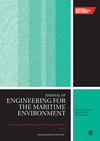海洋起重机磁流变防摆动装置的建模与分析
IF 1.5
4区 工程技术
Q3 ENGINEERING, MARINE
Proceedings of the Institution of Mechanical Engineers, Part M: Journal of Engineering for the Maritime Environment
Pub Date : 2023-12-23
DOI:10.1177/14750902231213465
引用次数: 0
摘要
由于海洋环境的原因,船用起重机的运行效率较低,容易引发安全事故。本研究将磁流变(MR)技术应用于船用起重机有效载荷防摆动领域,设计了一种并联式磁流变防摆动装置。根据机器人理论和拉格朗日方法推导出了防摆动系统的动态模型。为提高防摆效率并降低能耗,设计了可变宇宙模糊 PID(VUFPID)控制器。对 MR 防摆动装置的防摆动效果进行了仿真和分析。结果表明,有效载荷的抗摆动效果超过 80%,在近似抗摆动效果下,使用 VUFPID 控制器的 MR 抗摆动装置的能耗比使用固定电流(1.9 A)的 MR 抗摆动装置降低了 49%。MR 防摆动装置的物理原型安装在实验室起重机上。实验结果表明,有效载荷的姿态降低了 80%。拟议的磁共振防摆动装置提高了船用起重机的效率。本文章由计算机程序翻译,如有差异,请以英文原文为准。
Modeling and analysis of magnetorheological anti-swing device for marine crane
Due to the marine environment, the operation efficiency of marine cranes is low, and it is easy to cause safety accidents. In this study, magnetorheological (MR) technology is applied to the field of payload anti-swing for marine crane, and designs a parallel MR anti-swing device. The dynamic model of the anti-swing system is derived based on the robot theory and Lagrange method. To enhance the efficiency of anti-swing and reduce the energy, the variable universe fuzzy PID (VUFPID) controller is designed. The anti-swing effect of MR anti-swing device is simulated and analyzed. The results show that the effect of payload anti-swing is exceed 80%, and the energy consumption of MR anti-swing device with VUFPID controller is reduced by 49% compared with MR anti-swing device with a fixed current (1.9 A) under the approximate anti-swing effect. The physical prototype of MR anti-swing device is installed on the laboratory crane. The experimental results show that the attitude of the payload is reduced by 80%. The proposed MR anti-swing device improve the efficiency of Marine cranes.
求助全文
通过发布文献求助,成功后即可免费获取论文全文。
去求助
来源期刊

CiteScore
3.90
自引率
11.10%
发文量
77
审稿时长
>12 weeks
期刊介绍:
The Journal of Engineering for the Maritime Environment is concerned with the design, production and operation of engineering artefacts for the maritime environment. The journal straddles the traditional boundaries of naval architecture, marine engineering, offshore/ocean engineering, coastal engineering and port engineering.
 求助内容:
求助内容: 应助结果提醒方式:
应助结果提醒方式:


